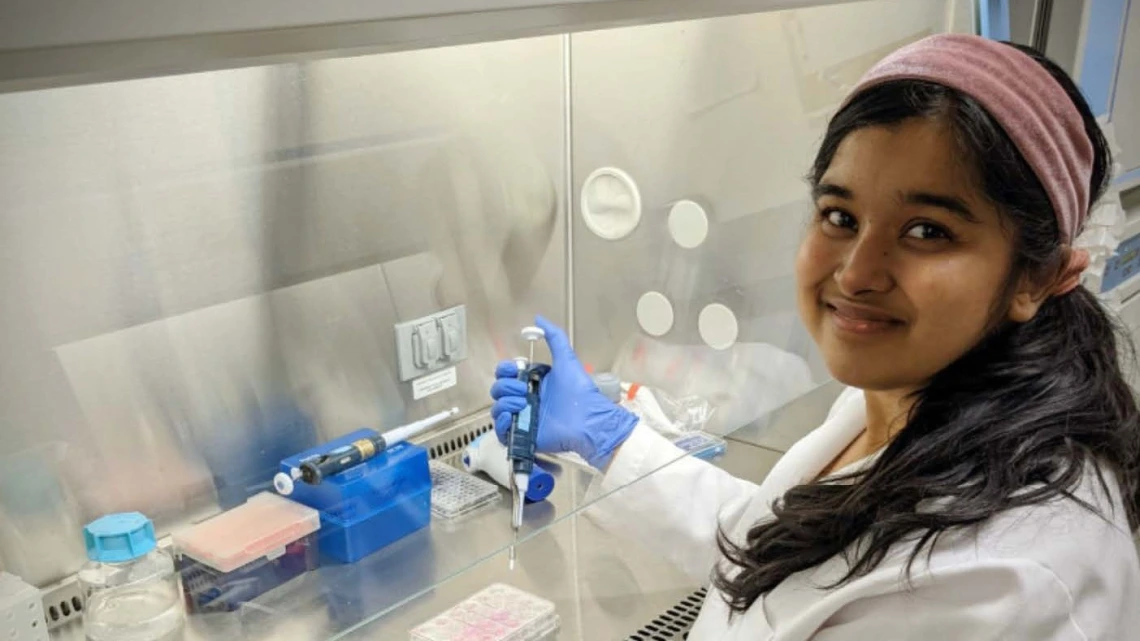A Host of Questions
UA Undergrad Hopes to Solve Brain’s Mysteries with Unique Parasite

Hannah Johnson
Shruti Attreya, a junior majoring in Neuroscience and Cognitive Science at the University of Arizona, does research in Dr. Anita Koshy’s Lab. The Koshy Lab investigates the molecular and cellular interactions between the host brain and Toxoplasma gondii, a parasite that infects many warm-blooded animals.
Lurking in the dirty cat litter, a single-celled crescent-shaped parasite waits inconspicuously for its next warm-blooded host. Aha! The litter cleaner forgets to wash their hands before eating. The parasite is now in its host!
In the host’s body, the parasite eventually reaches the body’s control center containing numerous folds and grooves. Here, the parasite finds its next host cell—the neuron.
Toxoplasma gondii (T.gondii) is a parasite commonly found in dirty cat litter boxes and raw or undercooked meat. The idea of such a parasite hanging out in the brain may sound scary. However, for researchers in the Koshy Lab at the University of Arizona, T.gondii serves as a unique tool to study the brain’s response to infection and disease.
Shruti Attreya, an undergraduate researcher in the lab and an aspiring physician, is interested in learning about neurological diseases. Through the Undergraduate Biology Research Program (UBRP), she is now working in the Koshy Lab to explore neurological disease from the perspective of T.gondii.
“Up to one-third of the world’s population is estimated to be infected with T.gondii. However, in most healthy people, T.gondii infection does not have symptoms,” said Attreya.
“There are very few microbes known to persist in the brain,” said Dr. Anita Koshy, an Associate Professor of Neurology and Immunobiology. Attreya is working with Dr. Koshy and Hannah Johnson, an MD-PhD student in the lab, to explore how T.gondii is able to accomplish this feat. Dr. Koshy theorizes that, “the parasite has figured out how to avoid or alter the brain’s immune response.”
In the brain, T.gondii preferentially infects neurons—brain cells that send communication signals. It establishes a chronic infection by creating/hiding in cysts in the neurons. These T.gondii cysts are sac like pockets containing many slow-growing parasites that can persist for the host’s lifetime and become reactivated in people with weak immune systems such as HIV/AIDS patients. This reactivation can lead to debilitating disease.
Attreya, however, is interested in exploring the receptors or signaling pathways in the host’s brain that may be involved in generating the host immune response to T.gondii infection. Receptors are important machines and function like switches in our bodies. When ‘turned on’ by certain molecules, these machines begin a series of events in the cell that not only contribute to the cell’s daily functions but also affect our bodies’ response to infection.
A previous study from the lab found that the molecules that bind to a receptor called Receptor for Advanced Glycation End Products (RAGE) are increased in the host brain during T.gondii infection.
RAGE plays an important role in many inflammatory processes. “Our immune cells are like the police,” said Attreya. When neurons are infected, they release special molecules that dial 911 to nearby immune cells that then fight the infection. A study from another lab also found that RAGE may have a role in activating this process during T.gondii infection in humans.
These findings led Attreya and her lab to further examine the role of RAGE in T.gondii infection. Attreya’s current project focuses on determining if infected brains that lack RAGE respond differently to T.gondii infection. To do this, she is quantifying the differences in infection outcomes between infected brains that have no RAGE and infected brains that have normal levels of RAGE.
One infection outcome Attreya is analyzing is the number of T.gondii cysts in the brain, and an exciting finding so far is that infected brains that lack RAGE have a significantly greater number of T.gondii cysts compared to infected brains with the normal levels of RAGE, suggesting that RAGE may have a role in the establishment or maintenance of T.gondii cysts. Attreya now hopes to conduct future studies to understand how RAGE may play a role in these processes.
Attreya believes this project has broad applications. Her mentor in the lab, Johnson, agrees. “Neurons under stress lead to degenerative and debilitating disorders; T.gondii allows us to stress neurons and target them, to understand exactly how they respond.” As the lab learns more about the role of RAGE in T.gondii infection, their findings may apply to other neuroinflammatory diseases, like Alzheimer’s disease, in which RAGE is thought to play an important role. Understanding the brain immune response may also help pave the way for new treatments.
For Attreya, this experience has been extremely rewarding, “Research can involve a lot of troubleshooting. However, the insight and mentorship afforded by research, my mentors, and UBRP go beyond what I can get in the classroom—I am able to actively learn and apply my skills to make a meaningful contribution to the scientific community.”
Also, she adds, “you learn a lot about a literal mind-boggling parasite which is so cool!”
Attreya’s work is supported and funded by UArizona’s Undergraduate Biology Research Program and the National Institutes of Health.
Shruti Attreya




